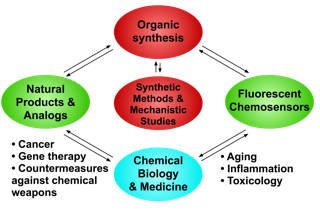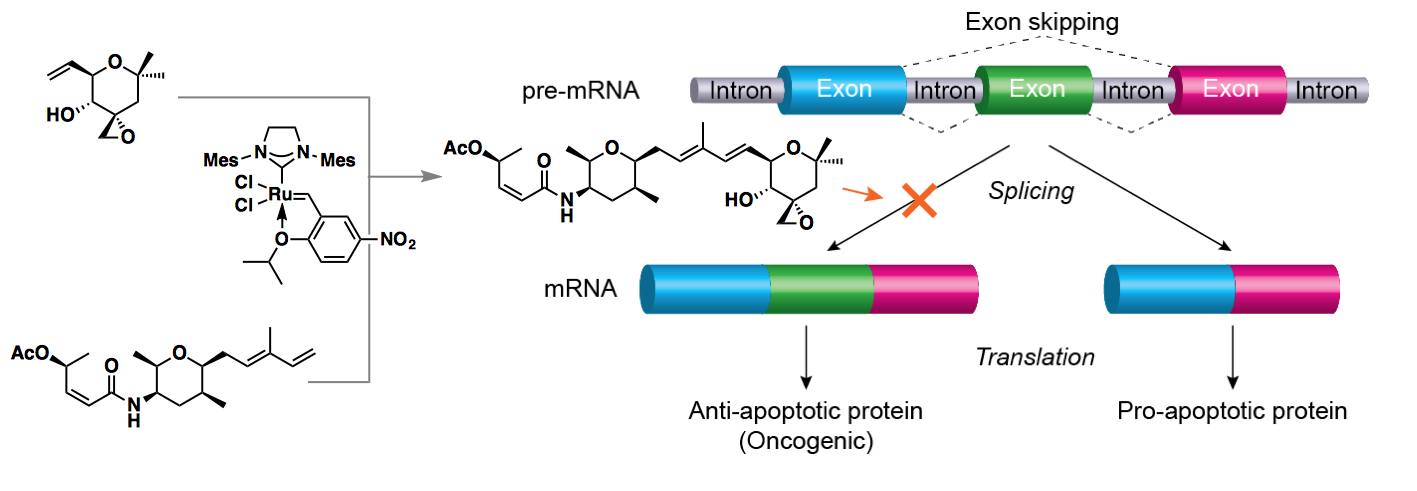
Contact
1201 CHVRN219 Parkman Avenue
Pittsburgh, PA 15260
412-624-8767
My Website >
Research Overview
Organic synthesis of natural products, new synthetic methods, and organic fluorescent sensors

Total Syntheses and Biological Studies of Natural Products
We are currently studying FR901464, a natural product that regulates cancer-related genes by novel mechanisms. This compound inhibits cancer proliferation at concentrations as low as 1 nM. To study FR901464, we completed a chemical total synthesis of this natural product. Combination of this powerful, stereocontrolled chemical synthesis and cell biology will provide insights into the molecular mechanisms of FR901464. More recently, we have developed an exceptionally active FR901464 analog (meayamycin) that inhibits tumor growth at 10 pM (analogouus to one pack of sugar (5 grams) at a coffee shop in 400 Olympic swimming pools).

Increased thermotolerance associated with tumors is a major problem in cancer radiotherapy, and such tolerance is mediated by heat shock proteins. Therefore, inhibitors of heat shock proteins are of great interest in medicine. Stresgenin B is a densely functionalized natural product that inhibits heat shock proteins. We have developed a new conjugate addition reaction and are applying this method to synthesize stresgenin B.
Development of Fluorescent Probes for Metals and Biomacromolecules
DNA transcription is the pivotal step in many cellular processes, and regulation of this complex biological event is essential for homeostasis. Currently available methods used to study this process do not enable real-time monitoring of DNA transcription in intact cells. To gain insights into the transient RNA levels of living cells in real-time, we are currently developing fluorescent sensors that visualize RNA.
Although palladium is widely used in synthetic organic chemistry and materials, it is known to be toxic. We have developed a fluorescent probe that can detect palladium in drugs. A commercial Pd detection kit is now available from Luminos, LLC.
Other fluorescent probe projects include the development of ultra-sensitive fluorescent probes for environmentally and biologically important molecules such as mercury and reactive oxygen species.

New Synthetic Methods
We are developing new synthetic methods based on the reactivity of alkynes and alkenes. Unique reactivities of zirconium, silver, tin, ruthenium, and other metals are being explored to discover new carbon-carbon bond forming reactions. Additionally, we developed new synthetic technology based on cross-olefin metathesis that allows for the synthesis of functionally diverse library compounds. Using this technology, highly functionalized library compounds are being synthesized in our laboratory.
Awards
- University of Pittsburgh Innovator Award 2019
- Merck Technology Collaboration Award (2014)
- University of Pittsburgh Chancellor's Distinguished Research Award, 2009
- University of Pittsburgh Innovator Award, 2008
- Thieme Chemistry Journals Award, 2007
- Merck Fellow of the Cancer Research Fund of the Damon Runyon-Walter Winchell Foundation, 1998-2000
- Naito Foundation Fellowship, 1991-1992